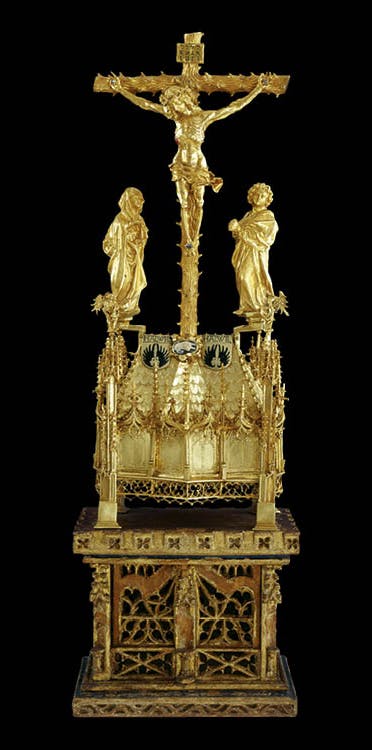
- Magazine Article
- Exhibitions
The Hallwyl Reliquary
An exchange loan from the Treasury of Basel Cathedral

Hallwyl Reliquary, before 1470; base, 1470. France, Strasbourg. Base by Mathias Frischmut. Crucifixion group: raised, cast, engraved, punched, and chased gold, with diamonds and a ruby; shrine: raised, cast, engraved, cut, and gilded silver, with opaque champlevé enamel, a sapphire, and a sardonyx cameo; base: gilt lindenwood; h. 58.7 cm. On loan from the Historisches Museum Basel, 1882.83
The Cleveland Museum of Art’s Portable Altar of Countess Gertrude is currently featured in a major exhibition at the Historisches Museum Basel in Switzerland. In exchange, that museum has graciously agreed to lend to Cleveland the Hallwyl Reliquary, a masterpiece of medieval goldsmithery, on view in gallery 109 until February 2020.
The reliquary originally belonged to the Treasury of Basel Cathedral, which has a long, violent history. Taking more than five centuries to develop, the remarkable collection includes liturgical objects such as patens, plates, censers, chalices, and ewers. The majority, however, consists of reliquaries, precious containers used to hold the physical remains of a holy person or site. The objects in the treasury are made of gold and silver and often encrusted with gems and enamels, since only the finest materials were suitable for celebrating God. The treasury’s wealth represented the power and status of the church and its donors while serving as a source of civic pride.
In February 1529 the treasury faced one of its greatest threats: the Reformation. More than 200 armed citizens stormed the cathedral, wreaking destruction upon everything considered idolatrous; not a single wood sculpture or painted panel survived. Remarkably the objects from the treasury escaped unscathed, having been locked away on an upper floor. This was only a temporary reprieve; the treasury faced its next greatest crisis in the early 1800s when a civil war ravaged the city. As a result, many of the objects in the treasury were dispersed and sold, more than half eventually finding a home in the Historisches Museum Basel. The rest were spread among collections around the world or lost.

One of the treasury’s finest sculptural works is the Hallwyl Reliquary, named after the family whose coat of arms appears twice on the shields affixed to the front. One represents Rudolf V von Hallwyl (before 1405–1473), from whom the cathedral acquired the shrine in 1480. Although the second shield may have been added purely for reasons of symmetry, it is believed to represent another member of the family. Originally attributed to Rudolf’s wife, it is more likely that of his cousin, the knight Thüring III von Hallwyl (1427–1469), whose death may have incited the sale of the reliquary to the cathedral to satisfy his debts.
Crowning the top of the reliquary is a scene of the Crucifixion wrought from gold. Flanking the figure of the crucified Christ are the Virgin Mary, who turns her grief-stricken face toward her son, and Saint John the Evangelist, who turns away, his hands folded in prayer. The nails in Christ’s hands and feet are marked with polished diamonds and the wound in his side with a ruby. The naturalistic treatment of the wooden cross stylistically links the reliquary to artists working in Strasbourg; for instance, the sawed-off ends are smooth in comparison to the rough, textured bark. At the base is an antique cameo with a recumbent lion, understood to represent Christ and the Resurrection. Above Christ’s head the traditional inscription identifying Jesus as King of the Jews, INRI, is rendered in Hebrew, Greek, and Latin.
This scene is attached to a gilded-silver shrine, the finest of the three in the treasury. It was made to resemble a miniature gothic building, complete with lancet windows, pinnacles, and buttresses; atop the four corners are angels holding incense burners and candles. A trap door at the bottom was used to access the relics that were once inside. Records indicate it held ampullas, or small containers, of Holy Blood, which were shown on feast days. Although the identity of the artist is unknown, there is no doubt as to the shrine’s origin, as the base features punch marks specific to a guild of goldsmiths active in Strasbourg.

To better display this treasure on the high altar of the cathedral, a gilded lindenwood base was fashioned in 1470, shortly after the reliquary shrine was completed. Archival records identify the woodworker as Mathias Frischmut, who was employed at the cathedral from 1470 to 1479. The base’s openwork panels mimic the gothic tracery seen on the shrine above. On each corner and in the front are niches that once held small figures, now lost.
Inventories from prominent European cathedrals help confirm the staggering wealth such treasuries once contained but then lost as they were pillaged during wars and revolutions, their materials cannibalized and sold to finance wars, feed populations, or rebuild towns. Escaping destruction during the Reformation and avoiding auction after Basel’s civil war, the Hallwyl Reliquary is a truly remarkable story of survival.
Cleveland Art, November/December 2019